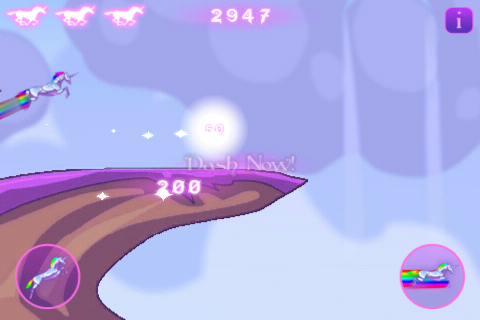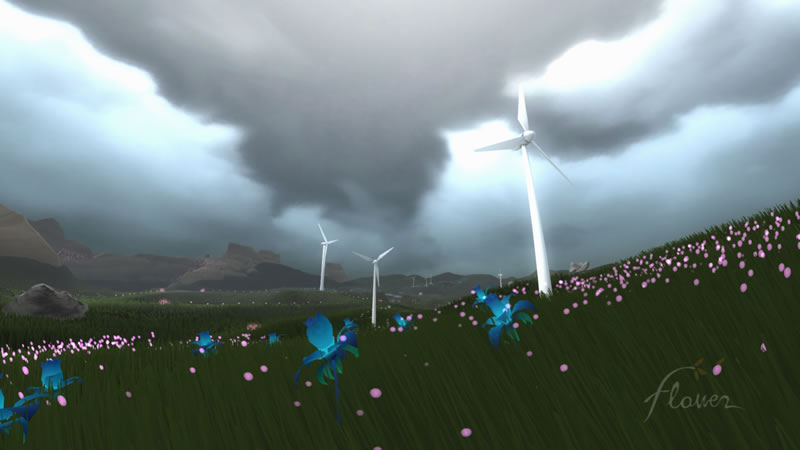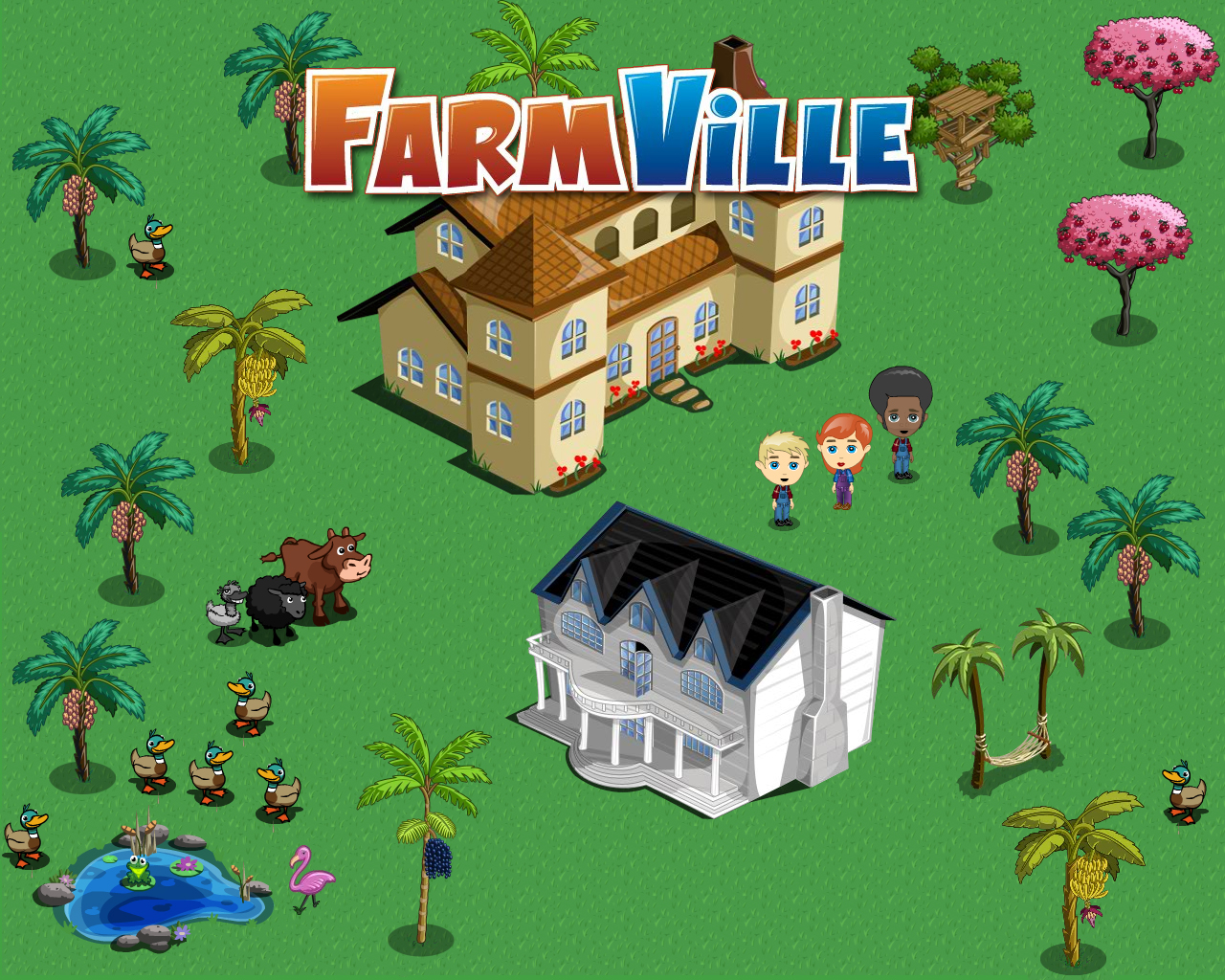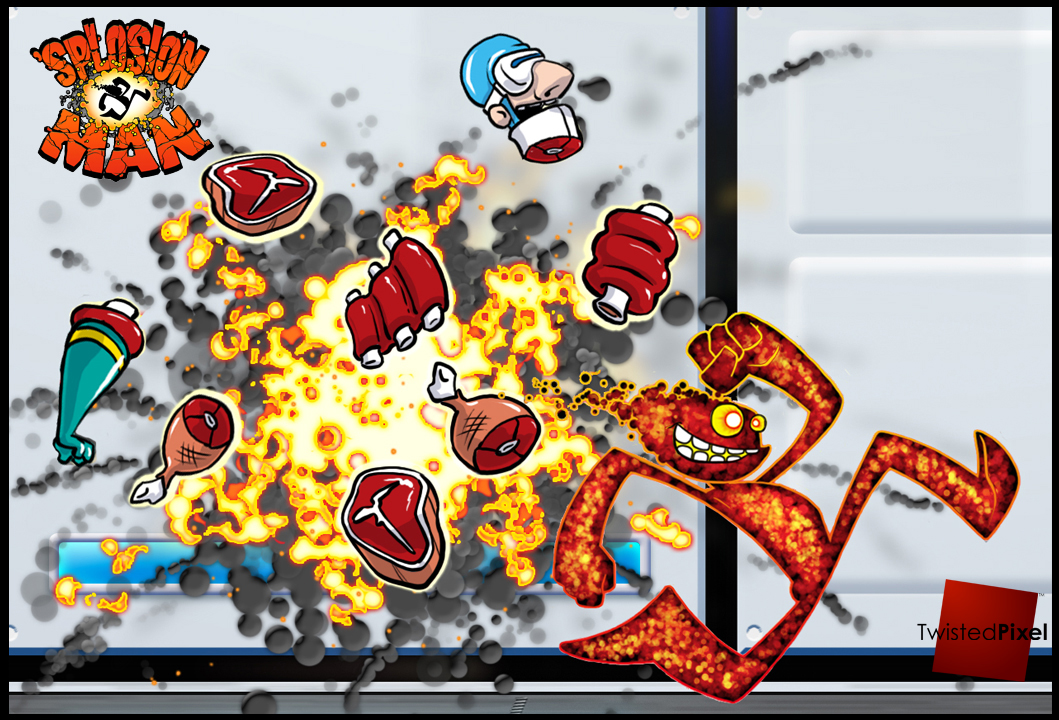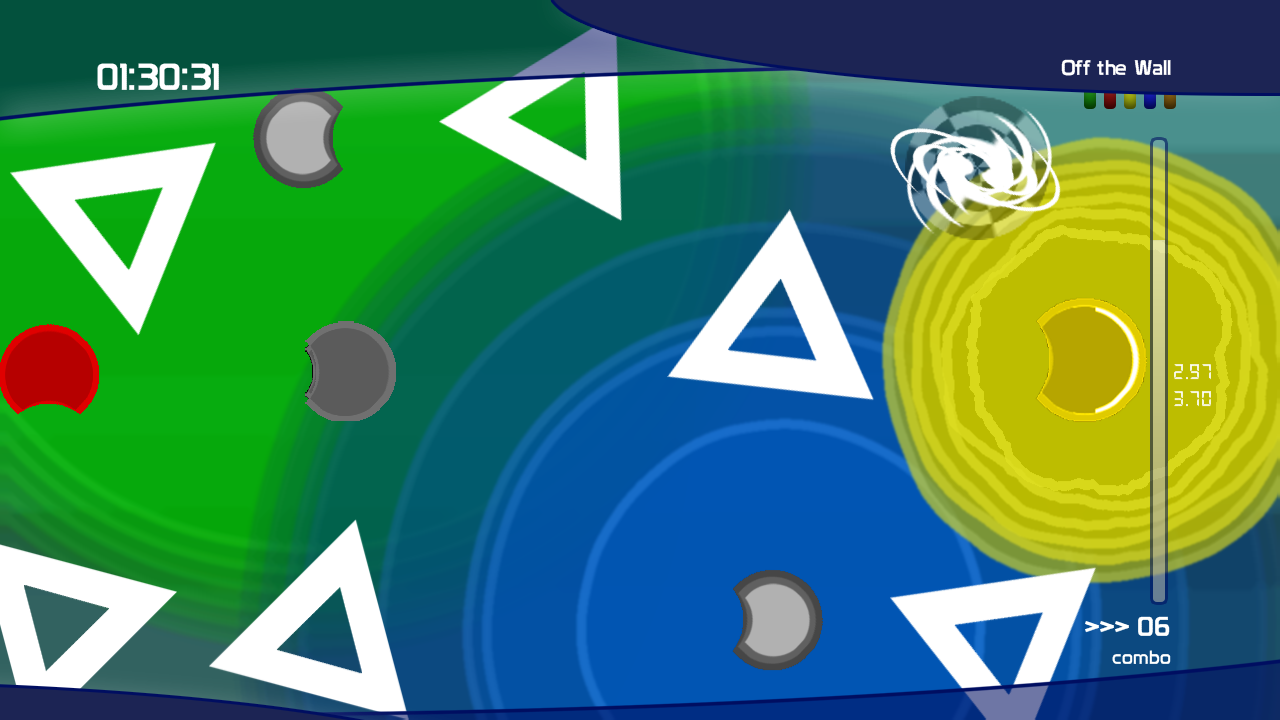Open your eyes, I see. Your eyes are open. Wear no disguise for me, come into the open. When it’s cold (when it’s cold), outside (outside), am I here in vain? Hold on, to the night, there will be no shame. When I was trying to decide which game to deconstruct next, I listed the games I’ve been playing the most recently. Then I pulled out my phone to send a text message and Robot Unicorn Attack stared back at me. I stopped playing just long enough to write this article. Robot Unicorn Attack Developer: Adult Swim Games Platform: Browser (link) / iPhone Genre: Imaginary Metacritic: N/A Price: Free / $2.99 (iPhone) Robot Unicorn Attack is a completely unoriginal game that managed to be better than its source material in just about every way. It clearly followed the example of indie darling Cannabalt, which is still a great game on its own. Whereas Cannabalt’s audience was limited to the hardcore gaming community, Robot Unicorn Attack made the gameplay more complex and found a much larger audience (over 27 million players according to the developer). It’s a rare failure of the K.I.S.S. principle. What’s so magical about this game? Gameplay The objective of Robot Unicorn Attack is to live as long as possible. The game instructs the player to “make your wishes come true” at the beginning of each round, with the subsequent reminder that “you will die.” The core gameplay consists of jumping, double jumping, and dashing from across floating platforms as the unicorn automatically runs to the right. The player’s score increases at a rate that grows every 5,000 points, and additional points can be earned by running into fairies or dashing through star-shaped rocks. The wish ends in a fiery explosion when the player runs into a wall, falls off the map, or hits a star without dashing. The two button gameplay (jumping or dashing) is deceivingly deep. The player’s success or failure depends on the timing of each jump or knowing when to double jump over an obstacle versus dash under it. The game’s increasing speed makes reacting to each obstacle even more difficult. The camera can be problematic,...
Read MoreGame Deconstruction: PixelJunk Shooter
Back in August, I committed to doing one decon per month. It only took two months for me to fall off track. Now I have to play catch up…but better late than never, right? This month I take a look at another downloadable title, this time for the PlayStation 3. I briefly played PixelJunk Shooter at E3, and although I was impressed with its visual style and ease of use, I didn’t know how long the game would be able to keep my attention with its simple mechanics. I picked it up based on the developer’s reputation for quality, and although it was a bit on the short side, it does a lot of things very well. PixelJunk Shooter Developer: Q Games Genre: Shooter / Puzzle Metacritic: 86 Price: $9.99 Length: 4-6 hours Background PixelJunk Shooter is the fourth entry in the Q Games’ PixelJunk series of PSN titles, following most recently the critically acclaimed PixelJunk Eden. It follows suit with the series’ reputation for high production value and polish. On the surface, the game isn’t very special – it’s a space-cavern exploration adventure along the lines of Subterrania for the Sega Genesis (I feel like this dates me), but its puzzle design is so innovative that it creates a very fresh experience. Its difficulty stems from its fluid-based physics puzzles, all of which force the player to think carefully about every move. The game isn’t particularly difficult, but it’s extremely clever. Gameplay Shooter consists of three worlds that have roughly five levels each. Each level is broken up into a handful of areas where a handful of crew members from the ERS Piñita Colada have been stranded. The player is tasked with rescuing all of the survivors in each area, without letting more than five die during the course of a level. All survivors must be rescued or killed (no one gets left behind) before access to the next area until the the final area is reached, where an escape gate opens to leave the level. The player cannot backtrack to areas they have completed without replaying the entire level. In the final area of each world, the...
Read MoreWhat I Played: 2009 Edition
For all the time I spent working, I still managed to play a lot of games in 2009. I’m late on the decons, but in the meantime I’ve put together a list of (almost) every game I played this year with a couple thoughts on things that stuck out to me about each of them. Apollo Justice: Ace Attorney – Capcom, Nintendo DS I was hesitant about the series ditching Phoenix, but in the end, I still got to yell “OBJECTION” at my handheld and that makes everything in the world OK. The updated investigation phase mechanics weren’t all that compelling even though they made good use of the DS. Maybe I was burnt out from the previous three games, but this one couldn’t keep my attention long enough to make it past the third case. Finished: NO Auditorium – EA, iPhone I played it first on PC, so buying the iPhone version was a no-brainer for me. It’s a great mobile game. The puzzles lend themselves well to the touchscreen, and levels can played in two or three minutes while waiting for a bus. I found the gameplay to be addicting enough that I finished it before I had the opportunity to play while waiting for a bus, opting to play it over Thanksgiving when I should have been socializing with family. EA offers more levels, but you have to feed the microtransaction monster to get to them. Finished: YES Batman: Arkham Asylum – Rocksteady, PS3 As most of the mainstream reviews have already noted, this one was a pleasant surprise. It’s one of the best stealth action games out there, even if the AI is fairly predictable. The combat system was intuitive and fun despite being so repetitive. None of the mechanics would have meant anything if Rocksteady hadn’t done such an amazing job with the game’s presentation. It truly makes the player feel like Batman, and even the collect-a-thon elements (Riddler trophies) were rewarding with Bioshock-esque tape recordings and backstory that went far beyond the genre’s usual offering. It’s a licensed game, but it’s also fun and innovative. What a concept! Finished: YES Boom Blox Bash...
Read MoreGame Deconstruction: FarmVille
“FarmVille? That stupid Facebook game that clutters my news feed all the time with random messages about lost pigs and ugly ducklings? Really?” When I decided I was going to do these deconstructions, Facebook games were the last thing on my mind. This time last month, I had never even played a Facebook game. I thought the very concept of Facebook games was backwards – I have Steam to play games on my computer, after all. Facebook should be strictly for staying in touch with friends. But after hearing that FarmVille has over 11 million active users on a daily basis – even more than World of Warcraft – I figured that there must be something about the game that the average Facebook user finds attractive. And in always trying to expand my knowledge of games, I finally gave in and started playing. FarmVille Developer: Zynga Genre: Simulation Metacritic: N/A Price: Free / Optional Microtransactions Length: Indeterminate Background FarmVille is Zynga’s answer to Farmtown, another popular farm simulator for social networks. Gameplay FarmVille is designed to be played in short segments of five to ten minutes every day. It’s a never-ending cycle of planting crops, waiting for crops to grow in real-time overnight or throughout the day, and then harvesting the crops before they whither. The objective of the game is highly open-ended, but players can progress by gaining experience points and “leveling up.” Each level unlocks a new set of crops for players to plant worth more than the previous ones. The game uses two types of currency: “coins” and “farm cash.” Players earn coins by planting and harvesting crops, but farm cash is much harder to come by. To get more than one farm dollar per day, a player has to spend real money through Zynga’s payment system. In the in-game marketplace, some things can only be bought with coins, some things can only be bought with farm cash, and others can be bought with either. Players can also earn “ribbons” (achievements) that reward them with coins, experience points, and gifts. There are four tiers for each ribbon, each more demanding than the previous. For example, the...
Read MoreGame Deconstruction: ‘Splosion Man
Here’s a concept I picked up from my room mates over the summer who interned at Pandemic Studios. Every week, one member of the team would pick a game and give a presentation on its strengths and weaknesses. There’s a lot to be learned about design by paying attention to the details that many players may overlook at first glance. As a personal experiment, I’m challenging myself to do one “game decon” every month for the next year. It’s one way I think I can work to make myself a better designer while providing some interesting reading material. I’ll try to not just pick “good” games, but this week I’ll start with one of my recent favorites… ‘Splosion Man Developer: Twisted Pixel Genre: Platformer Metacritic: 85 Price: 800 Microsoft Moon Dollars ($10 USD) Length: 4-10 hours Background ‘Splosion Man was conceived by Twisted Pixel’s lead designer, Sean Riley, as a game about “a guy who splodes in a world only made of glass.” The team started production in the middle of developing The Maw, their first original title. The game puts the player in control of a strange man-creature who “splodes” all the time without explanation. The game is controlled with the joystick and one button (which makes the character explode). The game’s plot is nearly non-existent, but the little story it offers is derived from its setting in the labs of the evil “Big Science” corporation. I’ve always been a sucker for good XBLA games, but ‘Splosion Man might be the best yet. I’ve told a few people that I think it’s the best game since Portal. After finishing up the single player game and getting about halfway through the co-op, I still feel like it’s at least the most satisfying gameplay experience since exploring Aperture Science. Both games take place in laboratories, and both games showcase cake as the ultimate object of desire. Twisted Pixel makes the homage obvious. Gameplay ‘Splosion Man features 50 single player levels, 50 co-op levels, and 3 boss battles. The core goal of the game is to use timing and skill to cross obstacles and reach the safe room at the end...
Read MoreAudiball Postmortem
I’ve wanted to write a proper postmortem for Audiball for some time now and I’ve been putting it off for far too long. Below, I try to summarize six months of my life into a few pages of text. Audiball was not a commercial success, nor was it groundbreaking in any way, but it was my experience with game development and I’ll always be proud of it. Read on if you’re interested in the game’s original vision, what sacrifices were made, what unexpected events changed development, how the game’s soundtrack was composed, how you can learn from my mistakes, and how an announcement trailer can be the longest fifty seconds of your life. Background Before starting development on Audiball, I was hooked on Jonathan Mak’s Everyday Shooter. Of course he’s already credited in the game for inspiration. It did a great job of using non-traditional sound effects in each level to blend with the game’s soundtrack. Each level used a different set of sound effects for shooting, explosions, combos, and just about everything else. It’s really what made the game exceptional as opposed to, well, your everyday shooter. Everyday Shooter At the same time, I was playing quite a bit of Rock Band with my roommates. The speakers on our TV blew out while we were in the middle of a difficult song, and while the guitarists and drummer were able to continue without a problem until it came back on, the singer promptly failed out. I guess I had never really considered that Rock Band is just a test of muscle memory. It’s why Guitar Hero is able to take away all the colors of the frets and players still know which buttons to push: the colors are irrelevant once you know where they are, it’s only the positions that matter. It was then that I got curious about the idea of focusing on the colors of the frets rather than their positions. It would be a completely different way of using the guitar controller. Of course, that also meant that no skills would carry over from any other guitar game. Playing Audiball for the first time would...
Read More